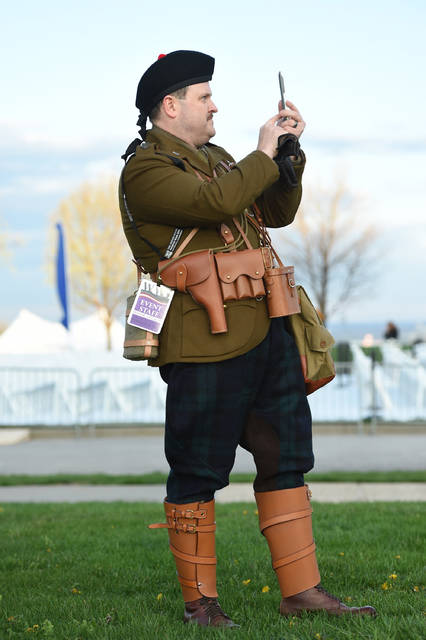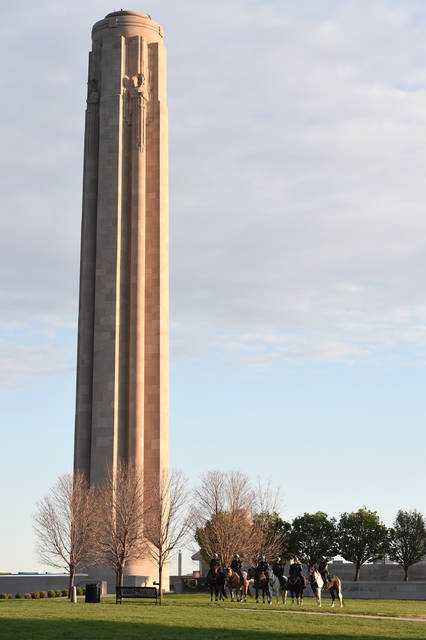KANSAS CITY, Mo. — A century after the United States joined its allies in the muddy trenches of Europe in a war unlike one the world had endured before, a Kansas City ceremony Thursday morning recalled the tragedy and heroism
KANSAS CITY, Mo. — A century after the United States joined its allies in the muddy trenches of Europe in a war unlike one the world had endured before, a Kansas City ceremony Thursday morning recalled the tragedy and heroism of the time.
Under clear skies and chilled air, a crowd gathered at the National World War I Museum and Memorial to mark the sacrifices, military and civilian, of a now-gone generation.
Dignitaries from 30-some nations joined Americans at the foot of the Liberty Memorial amid period music and military pomp and circumstance. Cannons fired. Music played. Military re-enactors gathered in period dress.
Descendants came, too. Helen Patton, whose grandfather George S. Patton led a tank squadron through France in World War I, was there. So were descendants of Gen. John Pershing, of Sgt. Alvin York, and of one of the bilingual Signal Corps switchboard operators known as the “Hello Girls.”
Patton talked about her grandfather honoring the first four American war deaths in France.
“He gathered strength from their sacrifices,” she said, and taught others to “never underestimate how much it means to hold a soldier in your heart.”
She read a poem and, a capella, sang about the yearning of those at home worried about soldiers at war. “It’s the spirit of the match that pulls you through … but at home she’s waiting … “
Several hundred who attended the ceremony heard a band play the songs of the different branches of the service, watched short films recalling the human cost of the war and listened to speeches about American troops crossing the Atlantic in defense of democracy.
“Today, we honor a generation of Americans no longer among us physically, but we can all sense their presence … a century later,” said Charles E. Schmidt, the national commander of the American Legion. “Their success in the Great War … laid a foundation not only for the American military, but for America itself.”
A century after April 6, 1917, the Kansas City gathering observed the world’s introduction to the carnage of modern warfare fought with tanks, from the air, with mustard gas and the devastating power of machine guns. Soldiers began the war on horseback and ended it in armored vehicles.
“They would become the parents of the greatest generation,” said Rob Dalessandro, the chairman of the World War I Centennial Commission. “World War I marked the true beginning of the American century.”
It came with dramatic changes in technology, medicine and society, he said, and marked the rise of U.S. influence around the globe.
“We still live in the long shadow of World War I in every aspect of our lives,” he told the crowd.
The European war began in 1914 but the United States did not enter the conflict until 1917 after Germany resumed unrestricted submarine warfare and continued to sink American merchant ships. The infusion of American forces on the side of France and the United Kingdom tipped the balance in favor of the Allies and against Germany. The war on the Western Front, and America’s participation, ended on Nov. 11, 1918.
The United States lost more than 116,000 people in the conflict to combat and disease.
It did not turn out to be the “war to end all wars” it was imagined at the time, U.S. Rep. Emanuel Cleaver told Thursday’s crowd.
“Even at this very hour, the threats loom large,” he said. Still the Kansas City Democrat said “this memorial reminds us of the sacrifice, the service and the significance of a determined nation. … The best of our country rose to the surface.”
U.S. Sen. Roy Blunt, a Republican who worked with Cleaver to establish the Kansas City site as a national monument, said it recognizes “an important part of our history that is also part of our present.”
The United States World War I Centennial Commission selected Kansas City as the site for the observance because of the Liberty Memorial, which is a national historic landmark and is designated by Congress as the National World War I Museum and Memorial. After the war, Kansas Citians raised the money to build the monument, with its 217-foot tower, on the hill opposite Union Station. It was dedicated in 1926 by President Calvin Coolidge.
Heads of state from France, the United Kingdom, Belgium, Germany, Austria, Hungary, Canada and Australia were invited to attend the centennial event, including President Donald Trump. Instead, the several nations were represented by ambassadors, ministers and other dignitaries. Representing the United States were Gen. Paul J. Selva, vice chairman of the United States Joint Chiefs of Staff, and Secretary of the Army Robert M. Speer.
Honorary hosts were Missouri Gov. Eric Greitens, Sens. Claire McCaskill and Blunt, Cleaver and Mayor Sly James. The mayor noted that 83,000 Kansas Citians in the 1920s raised $2.5 million —the equivalent of $34 million in 2017 dollars — to build the Liberty Memorial.
It is “a reminder of the high price of war. … fought in an effort to achieve peace,” James said. “That mission for peace is still being pursued.”
C-SPAN 3 is recording the 90-minute ceremony and will air it Sunday.




